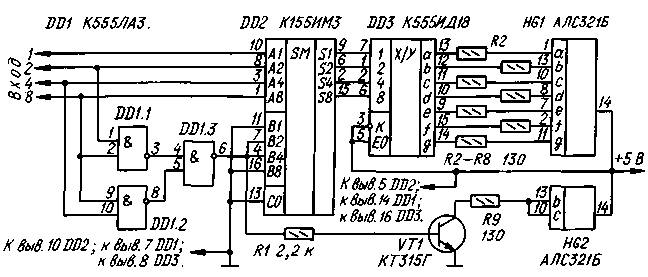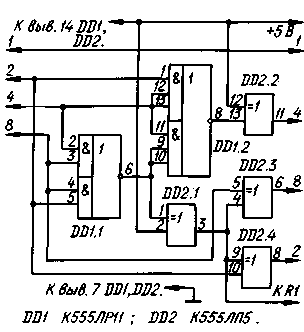
|
|
ENCYCLOPEDIA OF RADIO ELECTRONICS AND ELECTRICAL ENGINEERING Economical code converter for a seven-element indicator. Encyclopedia of radio electronics and electrical engineering
Encyclopedia of radio electronics and electrical engineering / Digital technology One of the important tasks facing the developers of electronic equipment today, both professionals and radio amateurs, is the all-round reduction of its current consumption. This problem can be solved in different ways: both by using economical microcircuits, and by creating new circuit solutions that require a smaller number of them. The author of the published article achieves his goal in both ways. In the article by Yu. Krivosheev "Binary Code Digital Signal Converter", published in the collection "To Help the Radio Amateur", no. 108 (M.: Patriot, p. 23), a device was described that allows using two seven-element indicators to display 16 states of a four-bit binary code. The device uses two code converters * K514ID2, which consume a significant current (50 mA each). I managed to assemble a device with the same functions on one code converter, moreover, less "gluttonous". A diagram of one of the device options is shown in fig. 1. The signals to the DD3 code converter do not come directly, but from the output of a four-bit adder DD2. An auxiliary node is assembled on the elements DD1.1 -DD1.3, which compares the input code with the code of the number 10. The input code is displayed by two seven-element indicators HG1 and HG2, corresponding to the units and tens digits. The HG2 indicator only shows the number 1. The node input signals are fed to the inputs A1, A2, A4, A8 of the adder DD2. If at the input there is a signal with a code number less than ten, the output of the element DD1.3 is low. At the inputs B1, B2, B4, B8, this is also a low level, so the input signals pass to the decoder DD3 unchanged. When a code of numbers from 10 to 15 appears at the input of the converter, a high level occurs at the output of element DD1.3. The inputs B1, B2, B4, B8 of the adder DD2 now receives the code number 6. The decoder DD3, thus, receives the code for the sum of the input number and six. For a four-bit binary code, adding six is equivalent to subtracting ten. At the same time, the HG1 indicator displays numbers from 0 to 5. The high-level voltage from the output of the DD1.3 element opens the transistor VT1, as a result of which the HG2 indicator shows one. In this converter, all three microcircuits consume a total current of about 75 mA. Instead of the K155IMZ adder, it is not only possible, but even desirable, from the point of view of reducing power consumption, to use the K555IM6 microcircuit (current consumption will decrease by another 20 mA). It should only be taken into account that its pinout has differences. The device is feasible without the use of an adder. Comparing the binary codes of numbers from 0 to 15 with the codes of numbers that should be fed to the DD3 code converter, one can notice the following features of the conversion. First, the signal of the least significant bit must be fed to the input of the code converter without change. Secondly, the signals of the second and fourth digits of a binary number, if it corresponds to decimal numbers from 10 to 15, must be inverted. These considerations underlie the operation of another version of the converter. On fig. 2 shows a fragment of the code converter diagram with changes.
Elements DD1.1 and DD2.1 play the same role as the elements DD1.1-DD1.3 in the previous version of the converter. While at the input of the converter there is a code of a number less than 10, a high level is active at the output of element DD1.1, and a low level is at the output of element DD2.1, turned on by the inverter. At this time, the elements DD2.3 and DD2.4 work as repeaters. If a code of a number from 10 to 15 is applied to the input of the converter, the output of the element DD1.1 will be a low level signal, the output of the inverter DD2.1 will be high, so the elements DD2.3 and DD2.4 invert the signals of the fourth and second digits arriving at them respectively. The signal of the third digit is formed in a special way using the element AND-OR-NOT DD1.2 and the inverter DD2.2. Element DD2.2 generates a high level at the output if the code of numbers 4-7, 14 or 15 is applied to the input of the converter. This version of the converter consumes less than 55 mA. Instead of K555LR11, in extreme cases, it is permissible to use the K155LR1 chip (the current consumption will increase by more than 50 mA). * Readers, especially inexperienced ones, may be confused by such an "incident": the device in question - a code converter - is assembled on two (or one) code converter chips. This contradiction is apparent. It is caused by the fact that the K514ID2 microcircuit, in particular, has a well-established name in practice and accepted in the technical literature - "code converter". A similar contradiction - for comparison: the pulse counter on two counters K1561IE20. We note in passing that some radio amateurs mistakenly believe that all microcircuits of the ID group are decoders. In fact, the decoder is a digital device, in which each working value of the input code corresponds to one activated output. For a code converter, each input code activates, as a rule, two or more outputs, i.e., the output is also a code. Many reference books also sin with this inaccuracy. Author: A. Shitov, Ivanovo; Publication: N. Bolshakov, rf.atnn.ru
Artificial leather for touch emulation
15.04.2024 Petgugu Global cat litter
15.04.2024 The attractiveness of caring men
14.04.2024
▪ External 2TB HDD Buffalo HD-PCFU3-C ▪ Rotating neutron stars to test and calibrate atomic clocks ▪ Ordinary dogs accepted the robot into their company ▪ Tourism helps treat dementia ▪ Protecting power grids from cyber attacks
▪ section of the site The most important scientific discoveries. Article selection ▪ article Mini-farm. Tips for the home master ▪ article Digital frequency converter. Encyclopedia of radio electronics and electrical engineering
Home page | Library | Articles | Website map | Site Reviews www.diagram.com.ua |






 Arabic
Arabic Bengali
Bengali Chinese
Chinese English
English French
French German
German Hebrew
Hebrew Hindi
Hindi Italian
Italian Japanese
Japanese Korean
Korean Malay
Malay Polish
Polish Portuguese
Portuguese Spanish
Spanish Turkish
Turkish Ukrainian
Ukrainian Vietnamese
Vietnamese


 Leave your comment on this article:
Leave your comment on this article: